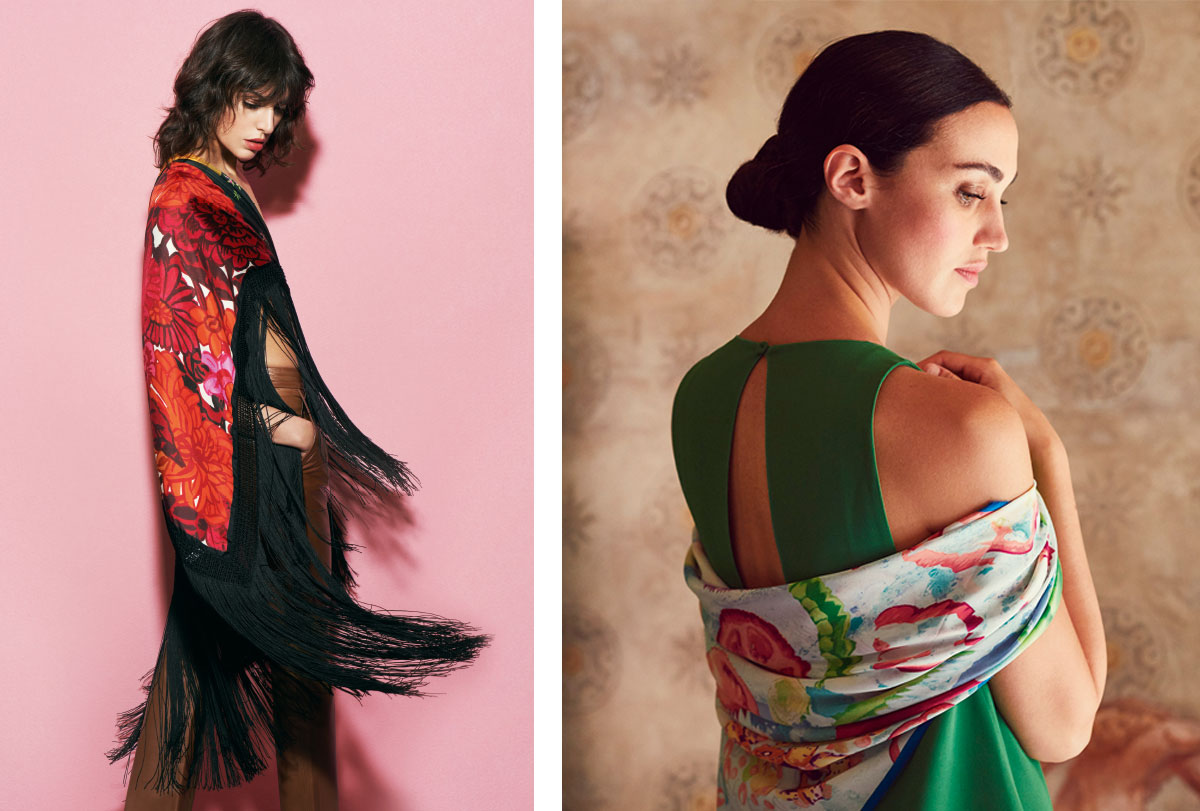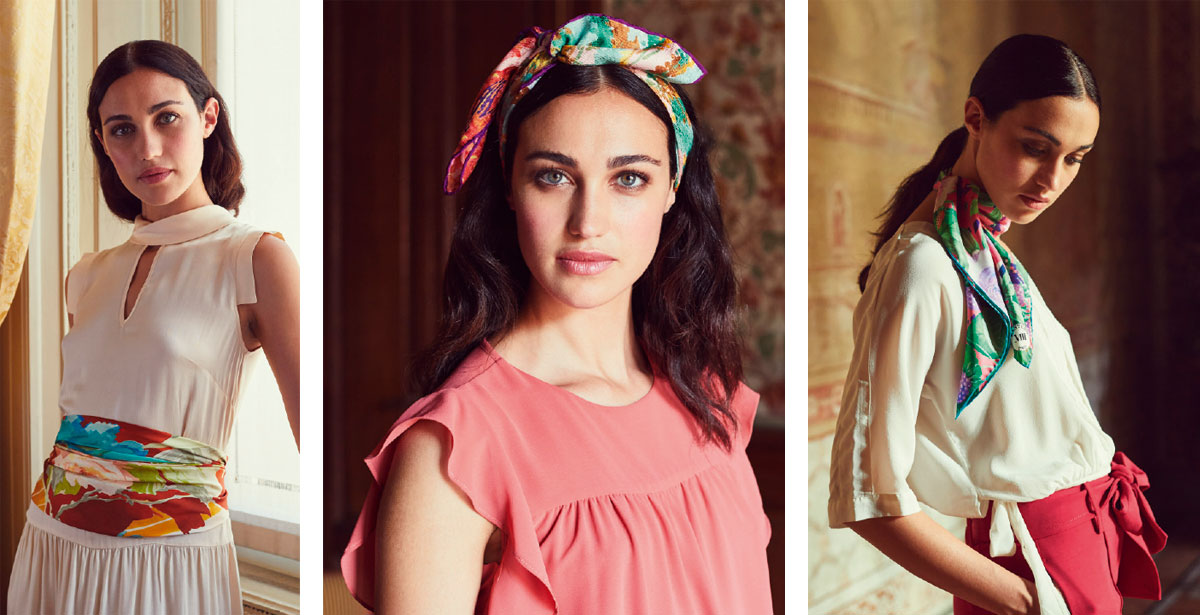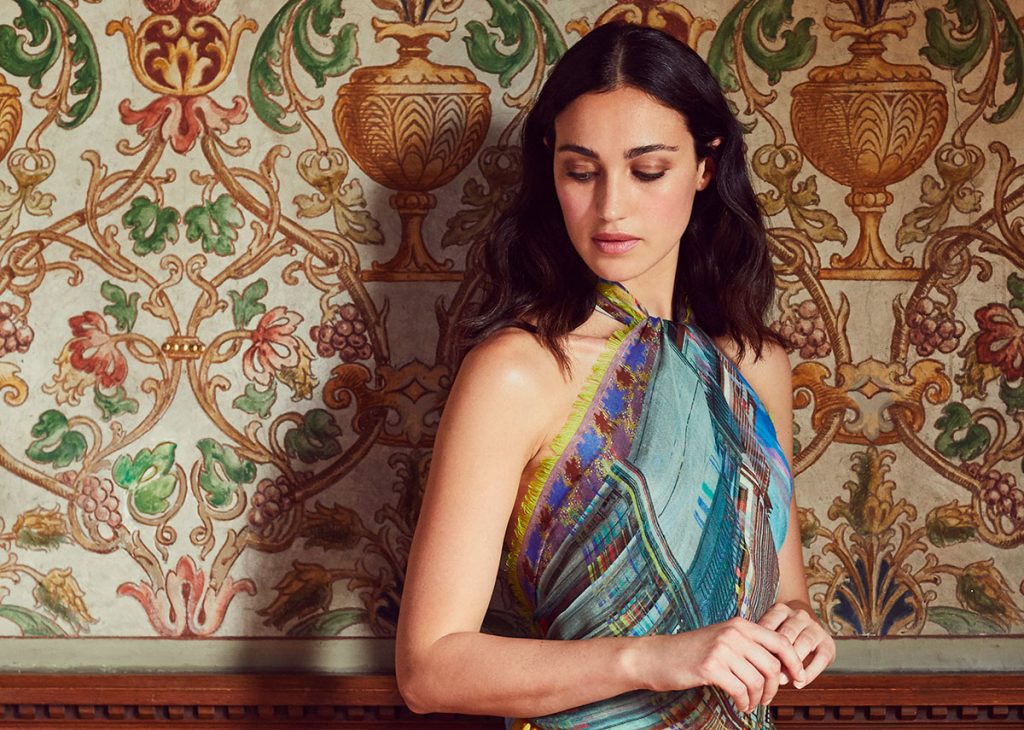Mantero 1902 has managed to impose their creations of romanticism mixed with irony. Holding a foulard of this brand in your hands means touching prints that are timeless but still capable of being perfect for our times.
The word “foulard” has its origins in the French term foulat, from foular meaning “to full”. “Fulling” is a particular wool finishing technique used in the textile industry. A foulard is a square piece of cloth. It’s usually in silk, but they can be made with any other fibre to make them warmer, more brilliant, more modern.
A record of the first ever foulards can be found in the Orient, in Chinese sculpture from the Chu dynasty (one thousand years B.C.). Indeed, part of the military uniforms of the time was a soft, thick scarf, and can be seen on terracotta statues. It was around 1400 when western women began to use this piece of square cloth to cover their heads as they went to church. Over the ensuing years it also came to be worn like a shawl to cover the cleavage.
In 1600 the foulard arrived at the court of King Louis XVI, most probably introduced by Croatian mercenaries. There it took the name cravat, while in 1700 its use became far more widespread, even amongst men. The Napoleonic army even used it as part of their uniform. Over the last century its use spread even further and effectively exploded in the post-war years. The ‘headsquare’ became an icon, a symbol of elegance and etiquette worn by the most chic, influential women.
Today it is an iconic, evergreen accessory, an item that goes beyond fashion, a square of cloth framing a piece of history, like the story of Mantero 1902.
Mantero is a company born in the silk district of Como with a core business dedicated entirely to weaving and printing fabrics for women’s apparel, and accessories (foulards, scarves, handkerchiefs and ties) for both women and men, for all the leading international luxury fashion brands.
The Mantero Archives hold 114 years of the company’s history in a collection of over 10,000 volumes and 60 foulards, in addition to tens of thousands of original designs filed according to theme, including test prints on paper, printed fabrics and well as solid colour and jacquard fabrics: a story of images and colours, fabrics and designs from the history of Mantero and all the brands associated with it over the years, enriched by acquisitions from major French, British, German and American textile archives, some of which dating back to the seventeen-hundreds.
Today Mantero has developed into a modern crafts workshop where products are born always through passion and tradition, and naturally the talent of designers from all over the world.
The designs initially take shape on paper and are then elaborated for transposition onto fabric. Still today, the traditional silk screen technique is a fundamentally important part of the overall production process. In this field, Mantero has demonstrated its absolute supremacy over the entire sector through its absolute virtuosity. Thanks to constant research and development even in this traditional field the company has managed to patent “DOUBLE”, a technique that makes it possible to obtain a print with the same design both on the front and on the back of the fabric, centred and with different colours, frame printing just one side of the cloth.

Since digital printing has developed enormously over recent years both in terms of technology and creativity, to the point of equalling and in some cases surpassing traditional methods in terms of definition and colour rendition, Mantero has equipped itself with new 16 head printers and presented a collection of designs with large, all-over and placed prints, conceived and developed to express the potential of this new technology to the utmost.
Mantero also develops designs for jacquard fabrics thanks to a group of young designers whose technical preparation is little short of enviable. The company offers a range of fabrics that differ by type and composition, with different weights, structures, looks and applications: from the lightest chiffon to fabrics for outerwear, clothing and accessories.
To find out more we went directly to the manufacturer with a series of questions about this particular accessory, which has lost nothing of its fascination despite the passage of time.
Everyone loves wearing a vintage foulard, especially a Mantero, but few know much about its history.
The history of the foulard is the history of our company because it’s the product of Italian excellence we’ve always been acknowledged for, both for the quality of the print and for the capacity to produce original designs thanks to our team of textile designers, not to mention the virtually limitless source of inspiration given by our Archives.
So you expect a renaissance of the foulard through the new Mantero marketing strategy?
The foulard is present in all shows and in all the collections. With respect to the “scarf” it’s certainly an item perceived as a niche product, while undoubtedly being acknowledged as a luxury, absolutely evergreen accessory at the same time. Our goal is to extend its appeal to a younger, more fashion-conscious clientele as well as to our actual, still classical customer base. For this we’re working on a more online-based marketing strategy. We’ve got a new website, social network presence and web marketing campaigns, as well as new brand ambassadors and a network of select boutiques

How is it that your foulards have become must-haves, collection pieces?
Without a doubt for the mastery of the design, the quality of the print, the richness of the colours and the precision of the details (finish, edging, embellishment)
The research of your illustrators has gained momentum over the years, to the point that each collection of Mantero foulards is awaited with great interest especially by collectors and buyers. Can you explain this phenomenon?
There are some in search of a heritage they don’t have and collect designs with a vintage flavour to draw from the past. Many new, recent brands in some way create little histories. We have over a hundred years behind us, and an immense body of proper “vintage” designs that we’ve begun to reinterpret and valorise in the coolest of ways through new graphics, developments to the bases and attention to the feels, finishes and embellishments (embroideries, fringes, etc.). This has renewed our foulards and made them contemporary while retaining the fascination of fashion thanks to a form of artistic research with a solid, historical base
Tell us about the new summer collection.
For summer 2018 we’ve renewed the patterns from the Archives with excursions into modern art (photography, futurism and, last but not least, glitch art)
On the other hand, for winter 2018 the collection will be even richer because we’ve extended the formats to include stoles and bandeaux, and emphasised the embellishments (feathers, fringes).
We’ve also renewed the feels of the fabrics with highly sophisticated garment-wash treatments not only on silk but on wool as well, and included “cult” items like a bag, a turban and a feather-padded stole.
If we had to choose an aphorism to summarise the spirit of this company, perhaps we’d take the title of the Patti Smith song “People have the Power”, because we believe that people and their ways of taking on challenge and living their lives are what makes the real difference in a product.

